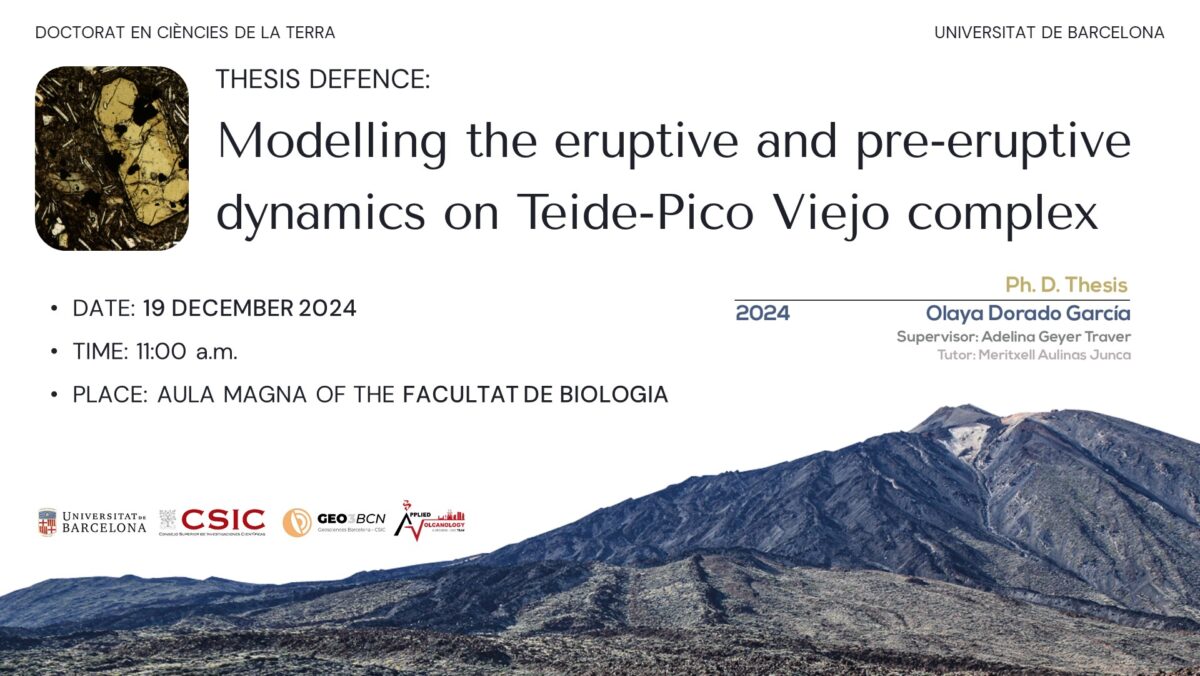Author: Olaya Dorado Garcia (GEO3BCN-CSIC)
Supervisor: Adelina Geyer (GEO3BCN-CSIC)
Mentor: Meritxel Aullinas (Universitat de Barcelona)

Thesis defense information
- December, 19th, 2024 | 11:00 AM
- Aula Magna, Faculty of Biology, University of Barcelona (UB)
Abstract
The volcanic island of Tenerife (Canary Islands, Spain), the largest and most populated island of the Canarian archipelago, hosts the active Teide-Pico Viejo (T-PV) volcanic complex in its central region, known for its high explosive potential. The volcanic activity of this central zone, along with the primarily effusive activity of the island’s two rift zones (Santiago and La Dorsal), poses a significant risk to the island’s population. Eruptions in Tenerife are infrequent, with estimated recurrence intervals of around 100 years for effusive rift eruptions, and approximately 1,000 years for phonolitic eruptions from the central complex. Therefore, studying past eruptions is essential to understand the volcanic activity on the island. The petrological and geochemical study of eruptive products, along with geophysical data, can help us understand the internal structure of the magmatic system and the pre-eruptive processes that influence magma evolution and eruptive dynamics.
Despite numerous studies conducted on the island of Tenerife, only a limited number has focused on studying the T-PV magmatic system as a whole. Furthermore, the few existing studies are outdated regarding recent advances in volcanology. Thus, the objective of this thesis is to improve our understanding of the active magmatic system in Tenerife, consolidating previous knowledge and contributing with new insights into the volcanic history, pre-eruptive conditions, and magmatic processes that have occurred on the island since the last caldera collapse (<180 ka). Special attention has been given to phonolitic eruptions, not only because they have the highest explosive potential, but also because they exhibit the greatest compositional variety. Additionally, this study aims to investigate whether significant differences exist between central phonolitic eruptions (originating from Teide) and those from the domes (felsic flank vents) that may explain the supposed difference in eruptive dynamics (effusive vs. explosive, respectively).
To conduct this research, we first reviewed both the geophysical studies carried out on Tenerife and the petrological and geochemical studies of the T-PV complex and the island’s two active rifts. The main goal was to unify all previous knowledge within a common framework, thus identifying potential knowledge gaps. The results of these reviews have been compiled into two databases: i) a database of geophysical observations and interpretations, which has allowed us to synthesize all information into a series of geological cross-sections illustrating Tenerife’s internal structure; and ii) a geochemical database of whole-rock analyses from the T-PV complex and the two active rifts (GeoTeRi). The latter database includes information on 561 rock samples, 540 major element analyses, 517 trace element analyses, 172 isotopic ratios, and 60 datings. The compilation of these datings, along with a review of published maps, has also enabled a reanalysis of the volcanic stratigraphy of the T-PV complex.
Secondly, we have conducted new sampling of eruption products (lavas and various pyroclast types) from the central T-PV complex outcropping within the Las Cañadas Caldera and from some eruptions of the Santiago rift proximal to the central complex. Whole-rock data were obtained for all these samples, thus complementing the data in the GeoTeRi database. Additionally, mineral chemistry analyses were performed on some of the collected samples. This allowed performing a general petrological and geochemical characterization of the recent eruptions from the central complex, as well as the identification of the different compositional groups within the magmatic series. Detailed studies were then conducted on some of these samples to calculate pre-eruptive conditions and identify pre-eruptive processes. The most relevant findings obtained from the study of these new samples include: i) the identification of several pumice levels potentially related to Teide eruptions, indicating a higher explosive potential than previously thought; ii) the calculation of pre-eruptive conditions for both the explosive and effusive phases of the Pico Cabras eruption, revealing that the changes in eruptive dynamics were related to differences in temperature and volatile content within a zoned magma chamber emplaced at 1 ± 0.5 kbar; and iii) the identification of various processes that explain some of the compositional variability found in the T-PV eruptions, including self-mixing processes, magma mixing, melting and recrystallization of feldspar-rich crystal mushes, and the remobilization and assimilation of the partial melting of these mushes. Some of these conclusions were reached through the comparison with a model for predicting partition coefficients of several trace elements in feldspars, allowing for the identification of xenocryst populations, a methodology applicable to other alkaline volcanic systems.
The joint interpretation of these new findings, along with pre-existing information on the volcanic system, has revealed that the shallow accumulation zones of phonolitic magmas are highly complex and that the active magmatic system in Tenerife exhibits the typical characteristics of a transcrustal magmatic system, with active crystal-rich mush zones in which the melt-rich domains are stored. Furthermore, the geochemical comparison of all studied samples has shown that there are no significant petrological or geochemical differences between Teide and the dome eruptions, indicating that the magmatic processes leading to the different compositional groups are not correlated with the vent area. It is therefore reasonable to infer that the pre-eruptive conditions of these compositionally similar eruptions are also alike. This observation challenges the previous hypothesis, which attributed the difference in eruptive dynamics to a variation in the storage depth between Teide and the dome eruptions. Our new hypothesis is further confirmed by the identification of pumice deposits from Teide eruptions. These findings are highly relevant for assessing volcanic hazard in Tenerife, as the explosive potential of Teide had been underestimated prior to this thesis, highlighting the need for further studies to identify recent explosive deposits from the T-PV complex.
